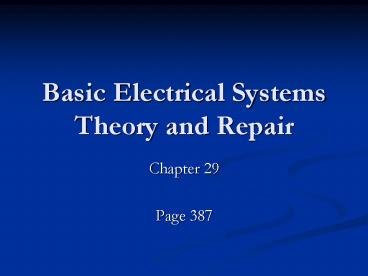Basic Electrical Systems Theory and Repair - PowerPoint PPT Presentation
1 / 53
Title:
Basic Electrical Systems Theory and Repair
Description:
Basic Electrical Systems Theory and Repair Chapter 29 Page 387 Measurements Voltage Testing Voltage Check Testing Voltage After Switch Open = wire broke or fried wire ... – PowerPoint PPT presentation
Number of Views:778
Avg rating:3.0/5.0
Title: Basic Electrical Systems Theory and Repair
1
Basic Electrical Systems Theory and Repair
- Chapter 29
- Page 387
2
So, Where is Electronics in a Car
- Everywhere
- Antilock brakes, engines, emissions, dash, fuels
system, transmissions, tires, suspension,
windows, safety systems, lighting. - ----Well, I could go on and on and on.
3
The Basics
4
Atoms
Positive
Negative
5
Conductors and Insulators
6
Conductors
Conductors A good conductor must not have more
than four electrons in the outer valence ring of
an atom. Copper is one of the best conductors
along with aluminum and gold, conductors have one
electron in the outer valence ring.
7
Insulators
Insulators A good insulator must have more than
four electrons in the outer valence ring of an
atom. Rubber, glass, and porcelain are the best
insulators with many electrons in the outer
valence ring.
8
Electrical Flow
9
Electron Movement
This is the way it really is! Negative to Positive
This is what we are taught! Positive to Negative
10
Wiring is coated with PVC, a flexible plastic to
insulate the copper wiring.
Color Chart
11
Circuit Requirements A full circle is provided
Switch
Source (Battery)
_
Source Battery or voltage supply Load
Electrical components, lights, radio,
etc. Complete path for electron flow Wires and
connections
12
Circuit Devices
Protection Devices
- Controls Devices
Switches for on and off
Fuses and Circuit Breakers Protect form Overloads
13
Fuses and Circuit Breakers
14
Other Symbols
15
Electrical Terms
- Voltage- Also called Electromotive Force,
Pressure of electricity or the amount of force it
takes to move electrons. Measured in volts. - Current- The movement or flow of electrons,
measured in amperes or amps for short. - Resistance-Anything that impedes or slows the
flow of electrons. Measured in ohms.
16
More Electrical Terms
- AC Alternating Current (shop lights and
equipment) - DC Direct Current (Auto battery and most
systems) - Auto voltage used is normally between 12 and 15
volts
17
Circuit Types
Series Parallel Combination
18
Series Circuit
19
Series Circuits
- Series circuits provide only one path for
electron flow through a circuit. - When one component fails, the remaining
components quit working.
Light
Light
20
Parallel Circuit
21
Parallel Circuits
- Parallel circuits provide two or more paths for
electron flow through a circuit. - When one component fails, the remaining
components are not affected.
Lights
12 v
22
Combination
- The simplest type is to use a switch in the first
part of the circuit (series) and the rest of the
circuit is wired in parallel.
Lights
12 v
23
Ohms Law
Greg Simon Ohm (1787 1854) Ohms Law It
takes one volt to push one ampere of current
through one ohm of resistance. Look at page 394
for more.
24
Ohms Law
E Voltage (Electromotive Force) I Current
(Intensity) R Resistance (Ohms) E IR I
E/R R E\I
25
Ohms Law
E IR I E / R R E \ I
E IR 12 3 X 4
I E / R 3 12 / 4
R E / I 4 12 / 3
26
Magnetism
Laws of magnetism 1. Like poles repel each
other. 2. Unlike poles attract each other. 3.
The attractive force increases as the
distance between the magnets decreases.
27
Magnetic Fields
28
Magnetism
Magnetic Field- Occurs when a current is flowing
through a conductor. Electromagnets- Artificiall
y creating a magnetic field. A coil of wire with
a voltage applied.
29
Electromagnets
Switch
Battery
Starter
Solenoid or Relay
30
Electromagnets
31
Resistors
32
A Few More Terms
- Semiconductors- Can act as both insulator and
conductor. - Diode- an electronic one way check valve, it
allows flow one way but doesnt allow it to
reverse the other way. - Transistor- electronic relay. Its very fast, and
no moving parts.
33
Basic Tests
- Meters
- Analog and Digital
Digital Volt-ohm Meter (DVOM) or Digital
Multimeter (DMM)
34
Measurements
35
Voltage Testing
36
Voltage Check
37
Testing Voltage After Switch
Open wire broke or fried wire
38
Circuit Test
3
1 12 v 2 12v 3 12v
1
2
2
39
Continuity Testing
40
Ohmmeter Test
41
Diode Check
Diode is a one way street only. Reversing the
multimeter leads will tell us if the voltage is
allows one way and is stopped the opposite way.
If it doesnt do this toss the diode.
.000 one way and 1. the other.
42
Testing Device with Ohmmeter with Power Removed
Continuity Should be .000 if Good
Infinity Should be 1. if Bad
43
Testing Amps
Need to change red probe lead to Amp on meter
44
Test Light
45
Test Light
46
Using a Jumper Wire
Bypassing Ground
47
Bypass a Switch with Jumper Wires
48
Circuit Defects
Open Incomplete or broken circuit. The circuits
quits working. Short Two wires unintentionally
connecting with each other. Could cause more
than one component to operate.
49
Circuit Defects
Ground When a positive and negative wire contact
each other. Could cause sparking and extreme
heat due to high current flow. Very low
resistance blows fuses, circuit breakers, or
fusible links.
50
Circuit Defects
Open Circuits
51
Circuit Defects
Short Circuits
52
Circuit Defects
Ground Circuits
53
Your Job.
- Complete chapter Questions 1-15 (review) and 1-10
(ASE-style). Page 401-402 - Write on a separate paper and write out the
complete question and your answer. ( do not write
the other answer options). - Complete the chapter worksheet (I will give it
out). You may write on it. - File all items in your note book.
- Notebooks will be graded in the future.































